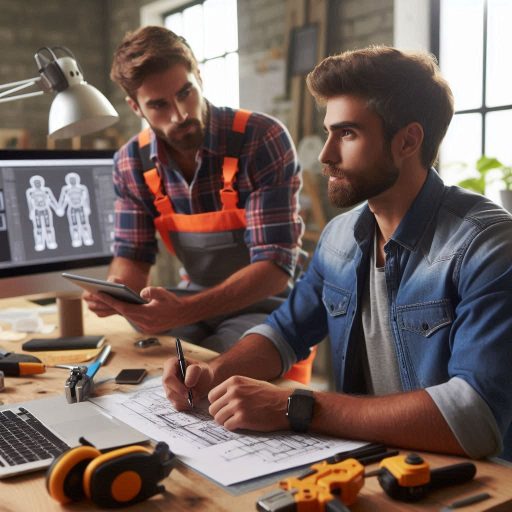Introduction
Role of Industrial Designers in Various Industries
Industrial designers play a key role across many industries.
They design products ranging from consumer electronics to medical devices.
Their work integrates aesthetics, functionality, and user experience.
Designers collaborate with engineers and marketers to create viable products.
They ensure that designs meet both practical and market needs.
Importance of Industrial Designers in the Creation of Products
Industrial designers are crucial in turning concepts into tangible products.
They shape how products look, feel, and function.
Their expertise ensures that products are user-friendly and visually appealing.
Designers contribute to product success by enhancing usability and marketability.
They balance form and function to meet user expectations and industry standards.
Challenges Faced by Industrial Designers
With great importance comes great challenges.
Industrial designers often face tight deadlines and budget constraints.
They must navigate complex technical requirements and manufacturing limitations.
Balancing innovation with practicality can be difficult.
Additionally, designers must keep up with rapidly changing technology and trends.
These challenges require creativity, problem-solving skills, and resilience.
Lack of clear communication with clients
The Importance of Clear Communication with Clients to Understand Their Needs and Expectations
Clear communication with clients is crucial for industrial designers.
Understanding client needs and expectations ensures that the final design meets their goals.
Effective communication helps in gathering precise requirements and avoiding misunderstandings.
It establishes a solid foundation for the design process and builds a strong client-designer relationship.
Designers must listen actively to clients’ feedback and ask clarifying questions.
This approach helps in capturing detailed insights into what clients envision for their project.
Clear communication channels facilitate the exchange of ideas and preferences, leading to designs that align with the client‘s vision.
Regular updates and feedback sessions are essential for maintaining clarity throughout the design process.
Scheduling these check-ins ensures that the design is progressing in the right direction and that any changes or concerns are addressed promptly.
This iterative process helps in refining the design to better meet client expectations.
How Miscommunication Can Lead to Design Errors and Dissatisfaction
Miscommunication between designers and clients can result in significant design errors and client dissatisfaction.
When designers misunderstand client requirements, the final product may not align with their vision or needs.
This misalignment often leads to costly revisions and delays, which can damage the client-designer relationship.
Errors in design due to miscommunication can also affect functionality and usability.
For instance, if a designer misinterprets a client‘s specifications, the product might not perform as intended, leading to further complications.
Such errors undermine the quality of the design and can result in negative feedback from clients.
Additionally, miscommunication can cause frustration and disappointment for clients.
When their expectations are not met, it can lead to a lack of trust and confidence in the designer‘s abilities.
Addressing these issues early on through clear communication helps in maintaining client satisfaction and avoiding project setbacks.
Tips on How Industrial Designers Can Improve Communication Skills with Clients
To enhance communication skills with clients, industrial designers should focus on a few key strategies.
First, use visual aids such as sketches, prototypes, or digital mock-ups to convey design concepts clearly.
Visual representations help clients understand the design better and provide more accurate feedback.
Second, practice active listening during client meetings.
This involves paying full attention to the client, acknowledging their input, and summarizing their points to ensure understanding.
Active listening demonstrates respect for the client‘s perspective and helps in gathering accurate requirements.
Third, establish clear and regular communication channels.
Use tools like email, project management software, or messaging apps to keep clients informed about progress and updates.
Regular communication helps in keeping clients engaged and ensures that any issues are addressed promptly.
Fourth, set clear expectations at the beginning of the project.
Define deliverables, timelines, and milestones to avoid misunderstandings later.
Transparent communication about what clients can expect helps in managing their expectations and avoiding surprises.
Finally, seek feedback from clients throughout the design process.
Encourage clients to review and provide input at various stages of the project.
This iterative feedback loop ensures that the design stays aligned with their vision and allows for timely adjustments.
Effective communication is vital for industrial designers to understand client needs and avoid design errors.
By actively listening, using visual aids, and maintaining clear communication channels, designers can improve their interactions with clients.
Implementing these strategies leads to successful projects and satisfied clients.
Tight deadlines and quick turnaround times
Pressure to Meet Tight Deadlines
Industrial designers frequently face pressure to meet tight deadlines.
This pressure often comes from clients, stakeholders, or internal project timelines.
Meeting these deadlines is crucial for maintaining client satisfaction and staying competitive in the market.
However, tight deadlines can create significant stress and impact the design process.
The urgency to complete projects quickly can lead designers to rush through critical stages of design.
Rushing often results in overlooking important details, which can compromise the quality of the final product.
Designers may struggle to balance speed with thoroughness, leading to potential issues in functionality, aesthetics, or user experience.
Impact of Tight Deadlines on Design Quality
Tight deadlines can adversely affect the quality of the design process.
When designers are pressured to work quickly, they may not have sufficient time to explore all design options.
This limitation can lead to less innovative or optimized solutions.
Important steps, such as user testing and iterative improvements, might be skipped or reduced, impacting the overall effectiveness of the design.
Additionally, the need to meet deadlines can lead to increased stress and burnout.
Stress can hinder creativity and problem-solving skills, further impacting the quality of the design.
The lack of time for reflection and refinement often results in a final product that might not fully meet user needs or design standards.
Strategies for Managing Time Effectively
To manage time effectively and meet deadlines without compromising quality, industrial designers can adopt several strategies.
First, prioritize tasks by breaking the project into manageable phases.
This approach helps focus on the most critical elements and ensures that each phase is completed efficiently.
Implementing a well-organized project plan is essential.
Use project management tools or software to track progress, set milestones, and allocate resources effectively.
Tools like Trello or Asana can help keep the team aligned and ensure that deadlines are met.
Time management techniques, such as the Pomodoro Technique, can also be useful.
This method involves working in focused intervals, followed by short breaks.
It helps maintain productivity and reduces the risk of burnout.
Effective communication with clients and stakeholders is another key strategy.
Regular updates and clear discussions about timelines can manage expectations and provide early warnings if deadlines are at risk.
If challenges arise, address them proactively to find solutions or negotiate adjustments to deadlines if necessary.
Lastly, ensure that there is time allocated for testing and revisions, even under tight deadlines.
While it might be tempting to skip these stages, they are crucial for ensuring the quality and functionality of the final product.
While tight deadlines are a common challenge for industrial designers, effective time management and strategic planning can help mitigate their impact.
By prioritizing tasks, using project management tools, and maintaining open communication, designers can meet deadlines while preserving the quality of their work.
Read: Freelance vs. In-House Costume Design Jobs
Balancing creativity with practicality
Balancing Creative Ideas with Practical Considerations
Industrial designers often face the challenge of balancing creativity with practical considerations like cost and feasibility.
While innovative ideas drive the design process, practical constraints must be addressed to ensure the project‘s success.
Designers need to align their creative visions with budgetary limits and manufacturing capabilities.
Cost is a major factor influencing design decisions.
Designers must find ways to implement creative ideas without exceeding budget constraints.
This often involves selecting affordable materials and optimizing production processes.
Balancing aesthetics with cost ensures that the final product is both visually appealing and economically viable.
Feasibility is another crucial consideration.
Designers must evaluate whether their creative concepts can be manufactured efficiently.
Complex designs may require advanced technologies or materials that are not always readily available.
Ensuring that designs are practical and can be produced at scale is essential for their success in the market.
Innovating While Adhering to Constraints
Industrial designers must innovate within the boundaries set by various constraints.
These constraints include cost, materials, production methods, and time.
Creativity thrives within these limits, pushing designers to develop solutions that are both inventive and practical.
Designers often use constraint-based innovation to their advantage.
For example, limited budgets can encourage the use of unconventional materials or simpler manufacturing techniques.
Constraints can also inspire novel solutions that might not have emerged in a less restrictive environment.
Innovation under constraints requires a strategic approach.
Designers need to prioritize features and functionalities that offer the most value while adhering to limitations.
This approach helps in making informed decisions that balance creativity with practical requirements.
Examples of Creative Solutions Within Practical Limitations
One example of innovative design within constraints is the IKEA flat-pack furniture.
IKEA‘s design team uses cost-effective materials and simple assembly methods to offer stylish and affordable furniture.
The challenge of minimizing shipping costs and storage requirements has led to creative packaging and modular designs.
Another example is the Tesla Model 3.
Tesla‘s design team innovated within the constraints of manufacturing costs and battery technology.
They developed efficient production techniques and utilized cost-effective materials to create an affordable electric vehicle without compromising performance.
The Nest Thermostat also illustrates how practical limitations can lead to creative solutions.
The design team combined user-friendly features with cost-effective technology.
The thermostat’s learning capabilities and sleek design were achieved through careful consideration of both functionality and production costs.
In summary, balancing creative ideas with practical considerations is a significant challenge for industrial designers.
They must innovate while adhering to constraints such as cost and feasibility.
By finding creative solutions within these limitations, designers can produce functional and appealing products that meet market demands.
Read: Networking Events for Costume Designers
Keeping up with evolving technology and trends
The Rapid Pace of Technological Advancements
The industrial design industry faces the challenge of keeping up with rapid technological advancements.
New technologies emerge frequently, transforming design processes and methodologies.
Staying updated requires constant vigilance as tools and techniques evolve at an unprecedented pace.
Technologies such as 3D printing, virtual reality, and advanced materials are reshaping design practices.
Embracing these advancements is crucial for remaining competitive and innovative in the industry.
Designers must adapt quickly to these changes, incorporating new tools and technologies into their workflows.
Failure to do so can result in outdated practices and missed opportunities.
The fast pace of technological progress makes it essential for designers to be proactive in learning and adapting.
Staying Current with New Tools and Trends
One significant challenge is staying current with new tools and design trends.
The introduction of innovative software and hardware requires designers to continually update their skills.
Emerging trends in user experience, sustainability, and manufacturing processes demand a fresh understanding of industry standards.
Designers often face the dilemma of balancing their current workload with the need for ongoing learning.
Keeping up with new tools can be overwhelming as it involves learning new software, understanding new materials, and adapting to new design philosophies.
Resources and Tips for Updating Skills and Knowledge
To overcome these challenges, industrial designers can utilize several resources and strategies.
Online courses and webinars offer flexible learning opportunities on the latest design tools and technologies.
Websites like Coursera, Udemy, and LinkedIn Learning provide courses on software and emerging trends.
These platforms allow designers to learn at their own pace and on their own schedule.
Attending industry conferences and workshops is another effective way to stay updated.
Events like the International Design Conference and local design meetups offer insights into current trends and networking opportunities.
These events provide a chance to learn from industry leaders and peers.
Joining professional organizations, such as the Industrial Designers Society of America (IDSA), provides access to valuable resources and industry news.
Membership often includes access to exclusive publications, industry reports, and professional development opportunities.
Additionally, following design blogs, subscribing to industry journals, and engaging with online design communities can keep designers informed.
Blogs like Core77 and Designboom offer updates on new tools, trends, and design innovations.
Networking with other designers through online forums and social media can also provide insights into how others are adapting to new technologies.
Sharing experiences and knowledge with peers can offer practical tips and solutions to common challenges.
In review, the rapid pace of technological advancements presents a significant challenge for industrial designers.
Staying current with new tools and trends is essential for maintaining competitiveness.
By utilizing online courses, attending industry events, joining professional organizations.
Engaging with design communities, designers can continually update their skills and knowledge, ensuring they remain at the forefront of the industry.
Read: Building a Portfolio for Costume Design

Dealing with feedback and criticism
The Challenge of Receiving Feedback on Design Projects
Receiving feedback, both positive and negative, is a common challenge for industrial designers.
Feedback is essential for growth but can be difficult to handle.
Positive feedback boosts confidence, but negative feedback can be discouraging.
Navigating this feedback effectively requires a balanced approach.
Designers often face criticism about their concepts, aesthetics, or functionality.
This can feel personal and challenging, especially when investing significant effort into a project.
However, understanding that feedback is about the work, not the individual, is crucial.
Constructive criticism aims to improve the design, not to undermine the designer.
Using Feedback to Improve Work
Designers should view feedback as an opportunity to refine their work.
Analyzing both positive and negative comments helps identify strengths and areas for improvement.
Positive feedback highlights what works well and can guide designers in maintaining those aspects in future projects.
Negative feedback, while challenging, provides valuable insights.
It often reveals areas where the design may fall short or where user needs are not fully met.
Addressing these critiques leads to more effective and user-centered design solutions.
Use feedback to adjust and iterate on designs, improving functionality, aesthetics, and overall quality.
Incorporate feedback into the design process by revisiting and revising concepts.
This iterative approach allows for continuous improvement and innovation.
Regularly seeking feedback throughout the design process helps identify issues early and makes it easier to implement changes.
Transform Your Career Today
Unlock a personalized career strategy that drives real results. Get tailored advice and a roadmap designed just for you.
Start NowStrategies for Handling Constructive Criticism
Handling constructive criticism involves a proactive and positive mindset.
Start by listening carefully and understanding the feedback.
Avoid reacting defensively; instead, ask clarifying questions to ensure you fully grasp the critique.
Separate emotions from the feedback.
Understand that criticism is about enhancing the design, not a personal attack.
Approach feedback with an open mind, focusing on how it can lead to better outcomes.
Reflect on the feedback and assess its relevance and applicability to your project.
Develop a plan for implementing changes based on the feedback.
Prioritize areas that need improvement and make adjustments accordingly.
This approach demonstrates responsiveness and willingness to grow.
Additionally, use feedback as a learning opportunity.
Analyze recurring themes in the feedback you receive to identify areas where you can develop new skills or knowledge.
This process helps you become more adaptable and resilient in your design practice.
Addressing the challenge of receiving feedback involves understanding its role in improving your work.
By using feedback constructively and implementing strategies for handling criticism, designers can turn challenges into opportunities for growth.
Embracing feedback positively enhances design quality and fosters professional development.
Read: Famous Costume Designers in Hollywood
Delve into the Subject: Balancing Creativity and Functionality in Lighting
Collaborating with interdisciplinary teams
Importance of Working with Professionals from Different Backgrounds in Design Projects
Working with professionals from different backgrounds is crucial in design projects.
Interdisciplinary teams bring diverse perspectives and expertise.
Collaborating with engineers, marketers, and material scientists enriches the design process.
Each professional contributes unique insights that enhance the overall quality and functionality of the product.
For example, an industrial designer working with engineers can ensure that design concepts are feasible and technically sound.
Similarly, involving marketers helps align the product with market needs and consumer preferences.
This collaboration leads to more innovative and practical designs that meet both aesthetic and functional requirements.
Diverse backgrounds also encourage creative problem-solving.
When team members with different expertise come together, they generate a broader range of ideas and solutions.
This diversity fosters a more comprehensive approach to design, addressing various aspects of the project more effectively.
Challenges of Communication and Coordination in Interdisciplinary Teams
Communication and coordination are significant challenges in interdisciplinary teams.
Different professionals often use specialized jargon and have varying priorities.
This can lead to misunderstandings and misalignment of goals.
For instance, designers may focus on aesthetics while engineers prioritize functionality and feasibility.
Coordinating between different disciplines requires clear and consistent communication.
Miscommunications can result in delays, rework, and conflicts.
It‘s essential to ensure that everyone understands the project goals and their role in achieving them.
Without effective communication, integrating various inputs can become problematic and impact the project‘s success.
Another challenge is managing diverse viewpoints and expectations.
Conflicting opinions on design decisions can slow down progress and create tension within the team.
Balancing these perspectives while maintaining a unified vision demands strong leadership and negotiation skills.
Tips for Effective Collaboration with Team Members to Achieve Successful Design Outcomes
To overcome communication and coordination challenges, follow these tips for effective collaboration:
- Establish Clear Objectives: Set clear, shared goals at the start of the project.
Ensure all team members understand and agree on these objectives. - Foster Open Communication: Encourage regular and open communication.
Use common language and avoid jargon that might confuse other team members. - Implement Structured Meetings: Schedule regular meetings to discuss progress, address issues, and align on next steps.
Use these meetings to keep everyone informed and engaged. - Use Collaboration Tools: Utilize digital tools for project management and communication.
Platforms like Slack, Trello, or Asana can streamline coordination and keep everyone on the same page. - Promote Mutual Respect: Respect each team member‘s expertise and contributions.
Acknowledge their perspectives and work towards finding common ground. - Create a Shared Vision: Develop a unified vision for the project that integrates inputs from all disciplines.
This ensures that everyone is working towards the same goals.
By applying these strategies, interdisciplinary teams can improve communication, enhance coordination, and achieve successful design outcomes.
Effective collaboration leads to innovative solutions and high-quality products that meet diverse requirements and expectations.
Overall, working with professionals from different backgrounds enriches design projects but presents challenges in communication and coordination.
By establishing clear objectives, fostering open communication, and using collaborative tools, teams can overcome these challenges and achieve successful design outcomes.
Budget constraints and cost-effective design solutions
Designing Innovative Products Within Budget Limitations
Industrial designers often face the challenge of creating innovative products while adhering to strict budget limitations.
Balancing creativity with financial constraints requires strategic thinking and resourcefulness.
Designers must find ways to push boundaries without exceeding budget limits.
This challenge involves making critical decisions about materials, manufacturing processes, and design features.
Finding cost-effective solutions while maintaining a high level of innovation can be daunting.
Designers must continually explore new methods and materials that align with budgetary constraints.
Creativity is essential, but it must be applied within the framework of financial reality.
Balancing Quality and Cost-Effectiveness
Balancing quality with cost-effectiveness is crucial in industrial design projects.
High-quality materials and processes can enhance a product‘s durability and appeal.
However, these elements often come at a higher cost.
Designers must ensure that the final product meets quality standards without exceeding budget limitations.
Striking the right balance involves prioritizing essential features and making informed trade-offs.
Focusing on core functionalities while optimizing production methods can help achieve this balance.
Effective communication with stakeholders about cost and quality expectations is also key.
By addressing these factors, designers can deliver products that satisfy both quality and budget requirements.
Strategies for Creating Cost-Effective Solutions
Industrial designers can employ several strategies to create cost-effective solutions without compromising design integrity.
One approach is to leverage modular design principles.
Modular components allow for flexibility and cost savings by enabling mass production of interchangeable parts.
This approach reduces manufacturing complexity and material waste.
Another strategy is to use advanced simulation tools during the design phase.
Simulation tools help identify potential issues and optimize designs before production begins.
This can prevent costly revisions and rework.
Designers should also consider alternative materials that offer cost savings without sacrificing performance.
Exploring new materials or suppliers can uncover options that fit within budget constraints.
Additionally, designers can focus on simplifying the design to reduce production costs.
Streamlining complex features or eliminating unnecessary elements can make a significant impact on overall expenses.
Collaboration with manufacturers early in the design process is another effective strategy.
Engaging manufacturers in discussions about production techniques and material choices can lead to cost-saving insights.
Manufacturers can provide valuable input on how to optimize designs for efficiency and cost-effectiveness.
Finally, adopting a phased development approach can help manage costs.
By breaking the project into phases, designers can test and refine designs incrementally.
This method allows for adjustments based on feedback and budgetary constraints, ensuring that the final product meets both design and cost objectives.
In a nutshell, industrial designers face the challenge of innovating within budget limitations while balancing quality and cost-effectiveness.
By applying strategies such as modular design, material alternatives, simulation tools, and early manufacturer collaboration, designers can create cost-effective solutions.
These approaches enable designers to maintain design integrity while meeting financial constraints, resulting in successful and innovative products.
Conclusion
Industrial designers face several common challenges in their field.
One major challenge is balancing form and function while meeting user needs and aesthetic goals.
Designers often deal with tight deadlines and budget constraints that impact their creative process.
Another challenge involves staying current with rapidly evolving technologies and materials, which can be overwhelming.
Overcoming these challenges requires resilience and creativity.
Designers must adapt quickly to changing requirements and constraints while maintaining high standards of quality.
Problem-solving skills are crucial for navigating design issues and finding innovative solutions.
Creativity helps in transforming limitations into opportunities for unique and impactful designs.
Industrial designers should seek support and collaborate with peers to address these challenges effectively.
Joining professional organizations or design communities can provide valuable resources and networking opportunities.
Staying informed about industry trends and technological advancements is essential for remaining relevant and competitive.
Encouragement to continue pushing boundaries is vital for growth in the field.
Embrace challenges as opportunities to innovate and refine your skills.
Keep experimenting with new ideas and approaches to enhance your design practice.
By staying resilient, seeking support, and maintaining a forward-thinking mindset, industrial designers can overcome obstacles and continue to make significant contributions to their field.
[E-Books for Sale]
The Big Book of 500 High-Paying Jobs in America: Unlock Your Earning Potential
$19.99 • 500 High-Paying Jobs • 330 pages
Explore 500 high-paying jobs in America and learn how to boost your career, earn more, and achieve success!
See All 500 High-Paying Jobs of this E-Book
1001 Professions Without a Degree: High-Paying American Jobs You Can Start Now
$19.99 • 1001 Professions Without a Degree • 174 pages
Discover 1001 high-paying jobs without a degree! Unlock career tips, skills, and success strategies for just $19.99!




